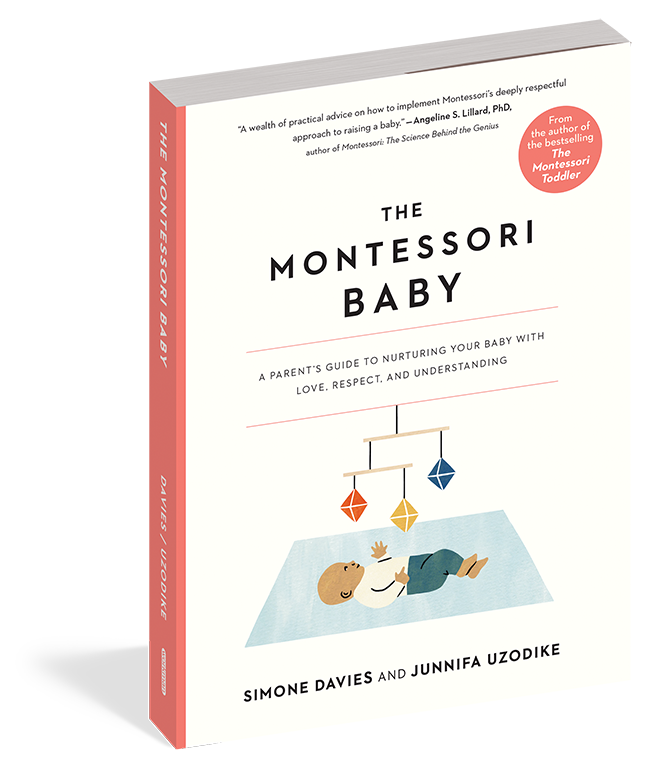Blame the pandemic or general tech fatigue, but there has been a clear spike in interest around Montessori education as more and more parents long to get back to “the basics.” Montessori is far from new, however. It has appealed to many people for years… many very successful people at that – just look at some famous people who were educated in a Montessori style. They include big names ranging from the founders of Google and Amazon, to Jacqueline Kennedy Onassis, Prince William and Prince Harry, to Sean ‘P. Diddy’ Combs and even Julia Child. Simone Davies, the Montessori expert behind the cult read The Montessori Toddler, is about to launch her highly anticipated new book The Montessori Baby (out on May 11) so we couldn’t think of a better time to chat with her to get insight into what exactly Montessori is, how to teach your little one its principles even if you don’t opt for a Montessori school and the must-dos for Montessori-style baby room decor so you can teach your little one how to be a self-starter from a very young age.

Momtastic: What exactly is a Montessori education?
Simone Davies: Montessori education, named after the pioneering physician and educator Dr. Maria Montessori, is a holistic type of teaching that allows the child to learn on their own individual timeline in their own unique way and following their interests. Looking around a Montessori classroom, there will be children working on different subjects, some working alone, some in pairs or some children in small groups at tables or stretched out on mats on the floor.
The classrooms are made up of mixed-aged kids—older children can help younger children, and younger children can learn from watching older children. There is a rich curriculum in all learning areas using tactile materials that are beautifully displayed on shelves. So each student decides what they want to work on, and the teacher acts as a guide, giving children lessons individually or in small groups.
Momtastic: For parents that aren’t planning on sending their kids to a Montessori school what are some helpful tips they should still consider incorporating?
Simone Davies: We can be our child’s guide – oftentimes as parents we are our child’s boss (constantly giving them instructions and nagging them) or their servant (doing everything for them). In Montessori, we act more as a guide encouraging the child’s independence allowing them to do so much more for themselves and we are available to help support them to build these skills. The children love to be able to contribute to the family and be involved in our daily life.
We can accept each child as they are – instead of having hopes and dreams for our child based on our own expectations or what we maybe missed in our own childhood, in Montessori we are reminded to observe our child with fresh eyes and see their gifts and where they might need assistance to build skills. We all want to be seen, heard and understood. We can offer this from birth (and even conception).
We can understand their unique interests – rather than top-down approach to learning where we as the adult teach our child what we want them to know, in a Montessori approach we “follow the child” in their interests. They love exploring and finding out about the world in a hands on way using their interests as a springboard to discover.
We can encourage curiosity – to encourage a child’s natural desire to learn, we offer them time to explore. We create a safe physical and psychological space (for example, where falling down ot making mistakes is part of learning) where they can make discoveries for themselves. And they learn that when we don’t know something, we find it out – who might know more about this? Is there a book in the library where we can find out more? Shall we visit a museum, art gallery, recycling plants or other to find out.
And we can have a respectful approach with them – our children are so capable, they ask fascinating questions, they come up with their own ideas, they don’t like to be interrupted just as we don’t and they like to have a feeling of agency. We respect them in our homes, and they learn to admire and respect us too.
Momtastic: For parents that are considering a Montessori school – what age is the critical age to have your child in a Montessori school in your opinion?
Simone Davies: Around 2.5/3 years of age, we observe the child looking for social relationships and additional challenges beyond the home. This can be a lovely time for them to start in a Montessori preschool for 3-6 year olds.
Before this, it may be that we need to work, so a Montessori nursery or daycare will offer the best care for our child. And it can be lovely to attend a Montessori playgroup in the first years (usually a couple of hours once a week), to allow the child opportunities for parallel play, to explore a Montessori environment and to learn how to apply Montessori at home.
Momtastic: At what age can parents start following Montessori principles?
Simone Davies: It’s never to early to start with Montessori. We can apply the Montessori principles from birth (and even from conception). We learn already to observe the child, to pause before responding to see what help they need rather than jiggling them or distracting them, and to allow the baby time to explore.
With a newborn, for the first six to eight weeks we are getting to know each other – what we call in Montessori the symbiotic period. In this period, we are helping the baby to adjust from the womb to the outside world. We can help them with this adjustment by keeping things slow and simple in these early weeks and having consistent points of references in our home from our voices (which are familiar from the womb), to the place where they sleep, bathe and are changed. A topponcino (a soft quilt) can be used to hold them which develops a familiar feel and scent to them and can make them feel secure and remove too much stimulation from being held, eg, by older siblings or visitors.
We can lie the baby on our forearms in front of us to have our first conversations. They gurgle and we gurgle back. We pause and they might gurgle again. This is different from baby talk where we make silly sounds but showing them we are listening and responding to them. And we make our hands slow and gentle when we touch them. By using our gentle hands, we are helping them to build trust in us and the world around them. We can tell them we are going to pick them up and wait for them to process what we have said showing them respect from birth. We may even start to see them lift their head or arms in response.
Momtastic: Can you outline the most important principles for setting up a child’s room in a Montessori way?
Simone Davies: Here are some principles from The Montessori Toddler for setting up our home in a Montessori way:
- Child-sized. Find furniture that the child can manage without help. Look for chairs and tables that are the right height to allow their feet to sit flat on the floor; cut off the legs a bit if necessary.
- Beauty in the space. Display art and plants at the child’s height for them to enjoy.
- Have activities and materials set up in trays and baskets so they have everything they need nearby; look for ways to make it easy for the child to help themselves.
- Attractive activities. Have age-appropriate activities beautifully arranged on shelves, rather than in toy boxes, that are inviting to them.
- Less is more. Displaying only a few activities helps children’s concentration; display only the ones they are working to master so they don’t feel overwhelmed.
- A place for everything and everything in its place. Toddlers have a particularly strong sense of order. When we have a place for everything and everything is in its place, it helps them learn where things belong, and where to put them away.
- See the space through their eyes. Get down to the child’s height in each space to see what it looks like from their perspective. We may see some tempting wires or some clutter under shelves, or it may feel overwhelming.
- Store and rotate. Create storage that ideally is out of children’s sight and easy on the eye—think floor-to-ceiling cupboards that blend into the wall color, an attic space, or containers that can be stacked in a storage area or behind a couch. Store most of the child’s activities, and rotate them on their shelves when the child is looking for new challenges.








